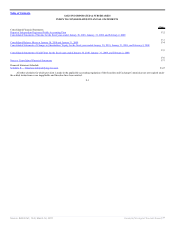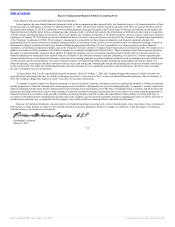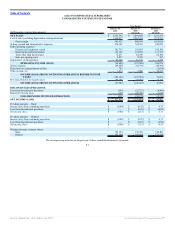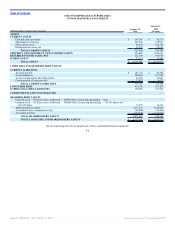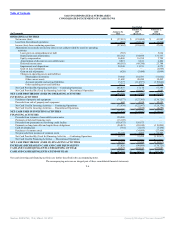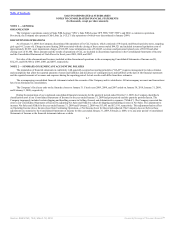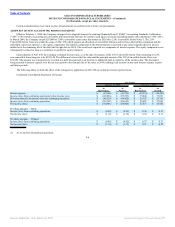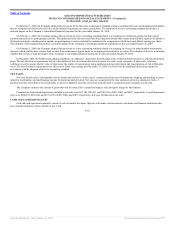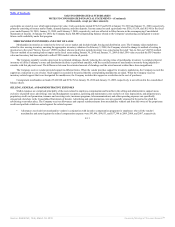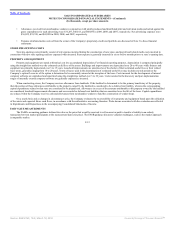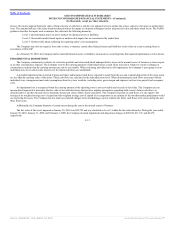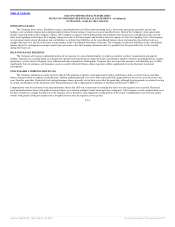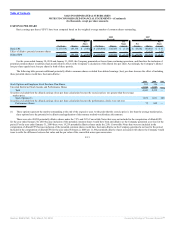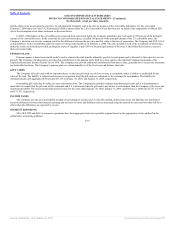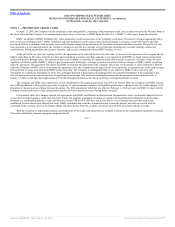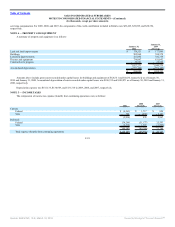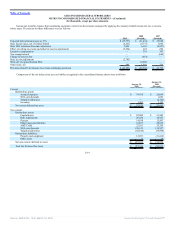Saks Fifth Avenue 2009 Annual Report Download - page 65
Download and view the complete annual report
Please find page 65 of the 2009 Saks Fifth Avenue annual report below. You can navigate through the pages in the report by either clicking on the pages listed below, or by using the keyword search tool below to find specific information within the annual report.
Table of Contents
SAKS INCORPORATED & SUBSIDIARIES
NOTES TO CONSOLIDATED FINANCIAL STATEMENTS—(Continued)
(In thousands, except per share amounts)
Condensed Consolidated Balance Sheet:
January 31, 2009
As Reported As Revised
Property and equipment, net $ 1,057,417 $ 1,058,393
Other assets $ 21,378 $ 19,948
Deferred income taxes, net $ 211,833 $ 194,956
Long-term debt $ 635,400 $ 593,103
Additional paid-in capital $ 1,105,199 $ 1,148,227
Retained earnings (accumulated deficit) $ (97,361) $ (115,423)
On February 1, 2009, the Company retrospectively adopted a new accounting standard which addresses whether instruments granted in share-based
payment awards are participating securities prior to vesting, and therefore, need to be included in the earnings allocation when computing earnings per share
under the two-class method. In accordance with the new accounting standard, the unvested share-based payment awards that contain non-forfeitable rights to
dividends or dividend equivalents (whether paid or unpaid) are participating securities and have be included in the computation of earnings per share pursuant to
the two-class method. The retrospective adoption of the new accounting standard did not have a material impact on the Company’s consolidated financial
statements for the years ended January 31, 2009 and February 2, 2008.
In May 2009, the FASB issued guidance regarding subsequent events, which was subsequently updated in February 2010. This guidance established
general standards of accounting for and disclosure of events that occur after the balance sheet date but before financial statements are issued or are available to be
issued. In particular, this guidance sets forth the period after the balance sheet date during which management of a reporting entity should evaluate events or
transactions that may occur for potential recognition or disclosure in the financial statements, the circumstances under which an entity should recognize events or
transactions occurring after the balance sheet date in its financial statements, and the disclosures that an entity should make about events or transactions that
occurred after the balance sheet date. This guidance was effective for financial statements issued for fiscal years and interim periods ending after June 15, 2009,
and was therefore adopted by the Company for the second quarter 2009 reporting. The adoption did not have a significant impact on the subsequent events that
the Company reports, either through recognition or disclosure, in the consolidated financial statements. In February 2010, the FASB amended its guidance on
subsequent events to remove the requirement to disclose the date through which an entity has evaluated subsequent events, alleviating conflicts with current
Securities and Exchange Commission (“SEC”) guidance. This amendment was effective immediately and therefore the Company did not include the disclosure
in this Form 10-K.
In June 2009, the FASB issued the Accounting Standards Codification (the “Codification”). The Codification is the single source of authoritative, U.S.
GAAP recognized by the FASB to be applied by nongovernmental entities. The Codification is effective for financial statements issued for interim and annual
periods ending after September 15, 2009. The implementation of the Codification did not have an impact on the Company’s consolidated financial statements.
On May 3, 2009, the Company adopted the provisions of a new accounting standard related to disclosures about the fair value of financial instruments,
which requires publicly-traded companies to provide disclosures on the fair value of financial instruments in interim financial statements.
F-9
Source: SAKS INC, 10-K, March 18, 2010 Powered by Morningstar® Document Research℠




